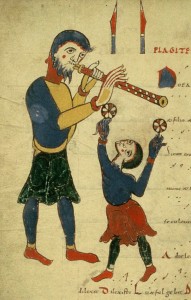Over Christmas and New Year I finally found the time to read a book which has been on my shelf for some time, GK Chesterton’s biography of Francis of Assisi. I have been drawn to Francis’ story for some time, instinctively sensing a connection between his ministry and the needs and concerns of our own time and of the church.
One aspect of his life and legacy has struck me in particular – the relationship between the growing Franciscan movement and the institutional church of the time. The stories of how Francis imagined and positioned his new missional order of monks are hugely insightful for those leading missional movements within the traditional denominations of the western church.
When Francis first drew a small group together under his leadership, they were three unlikely comrades, living in a hut attached to a derelict church in Assisi. He called the group the Jongleurs de Dieu. Jugglers of God. Or perhaps jesters, acrobats, tumblers of God. Jongleurs were travelling entertainers, circus-like performers whose playful skills were in deliberate contrast to those they were very often partnered with, the troubadours. Before Francis’ vision and call, he had a group of his young friends has been well known in Assisi for calling themselves troubadours. Troubadours, who emerged from southern France, travelled about singing romantic songs and offering a critical satirical, but essentially serious, commentary on love and romance. In shifting from troubadour to jongleur Francis was consciously signaling a liberation from the consciously solemn expressions of love and valor to something more playful, yet still consistent and true. The name Jongleurs de Dieu represented an openness to an expression of faith and service that was open ended, passionate without being weighed down by the heaviness of honour, almost frivolous in its riskiness, prodigal in its commitment to the provision and grace of God.
It is perhaps easy to imagine Francis’ reimagining of himself as a conscious critique of the church’s solemnity and order. However, Francis appears not to have seen it like this at all. His choice of the image of jongleur suggest something quite different. For where troubadours and jongleurs travelled together it was the jongleur who was the secondary partner, the servant in the duo of performers. Francis deliberately positions his movement, even at this embryonic phase, as a servant to the traditional church. His vision of a movement of committed disciples freed from the some of the strictures of life and institution, possessing nothing, giving everything, amidst the people not separate from them, was to act as an essentially servant-hearted movement in partnership with the traditional church. Francis himself has no vision of glory or growth, at least in the sense that we might use it. His was a vision of renewal forged from humility and service to the poor and the ordinary person, so often alienated from the language, culture and structures of the institutions. And his was a vision of church renewal not empire building, or church critiquing. He was not interested in creating a sect, in the way that the Fraticelli, a movement that grew after Francis death, sought to be. He was not interested in creating a perfect vision of the sort of church that was needed, or that ought to be. His vision was of imitating Christ, not imagining the ideal church.
I believe this is a hugely refreshing vision for our own time. God is once again creating jongleur de Dieu, people with a vision to be foolish in the eyes of many and create new kinds of community amongst the poor, the dispossessed and the marginalized. But too often the language and discourse becomes sectarian. A language that starts imagining such communities or movements in contrast to the church they have emerged from. A discourse that begins to battle for supremacy on the field of the perfect of church. As one such jongleur I firmly believe we are called to refrain from critique and stick to our call to playful, risky, frivolous and passionate imitators of Christ in new contexts. And to do so in such a way that we do not set ourselves up as paragons of the new Jerusalem, but humble servants of it and within it. The centre of the church has consistently been renewed from the edge, Francis being only one such example. However, it has also failed on numerous occasions to allow the new life at the edge fully invigorate the centre, either by the centre throwing it out, or the edge spinning off and creating its own distinct centre. Francis consciously worked for a renewing movement that if it critiqued did so by example. A movement that continued to dance with its rather stiff partner toward a new vision for the whole church.
